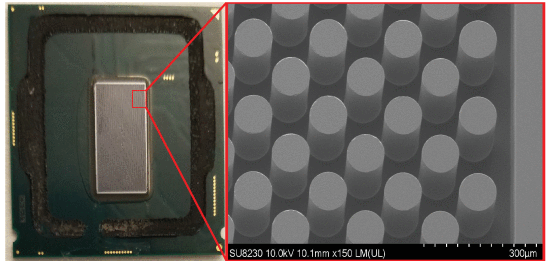Microfluidic Cooling on Overclocked Intel i7-8700K Drops Thermal Resistance 44%
Testing future cooling solutions for CPUs
Have you ever wished for a better way to cool your uber-clocked CPU? A team of researchers with Microsoft and Georgia's School of Electrical and Computer Engineering did, and took the matter into their own hands by applying a microfluidic heatsink on Intel's well-beloved Core i7-8700K CPU (6-core, 12-thread Coffee Lake). Then they overclocked it for good measure! The result? They were able to cool up to 215W of power from a stock 95W TDP CPU using only room-temperature water, decreasing thermal resistance by a staggering 44.5% against the original heatsink cooling design (with liquid cooling).
The Core i7-8700K hasn't been at the top of our best CPUs for gaming list in quite some time, but it marked Intel's transition from requiring HEDT for more than four CPU cores to a more competitive mainstream platform. More critically, 215W of power draw in the small 149mm^2 die area represents a lot of thermal density. The Core i9-12900K by comparison has a 215mm^2 die size, with a 125W TDP and 241W PL1/PL2 rating. Going after the smaller chip while pushing similar power thus represents a more demanding cooling scenario.
Microfluidic cooling takes its name from micro-channels that are integrated into — or, in this case, added to — a chip's design. Water passes through these channels, which are isolated against the chip's transistors (usually on the back of the active circuitry), and cools them in a much more effective way than the traditional heatspreader approach. Heat flows upward from the transistors through a Thermal Interface Material (TIM, which can sometimes be metal-based) and through a CPU's heatsink. Only then is the heat taken away from the CPU by heating the contact plate on your air- or liquid-cooler of choice.

The researchers' microfluidic cooling design has the claim to fame of having been adapted to an off-the shelf CPU. To do so, they removed the CPU's heatspreader and TIM, transplanted into a specially-designed silicon carrier wafer, and then etched microfins directly onto the top silicon layer — the last frontier between the world and the active transistors underneath. They then inserted the chip and carrier wafer into the motherboard, and added another silicon layer on top of the microfinned CPU, etched with an entry and an exit port for the water itself. Finally, they 3D-printed the water-cooling delivery manifolds onto the top of this last layer.

The researchers then had to test their CPU - but not just at its stock frequencies. That would be too low a burden for the impressive cooling capability of their microfluidic implementation. The rest of their test setup looks pretty typical, making use of HWInfo for temperature and load analysis, while running the CPU in both stock and overclocked states under the popular Cinebench R20 and Prime95 workloads.
Within those workloads, the researchers achieved stable operating frequencies at up to 5.2 GHz for Cinebench R20 and 4.5 GHz for Prime95, a 40% and 21% increase respectively compared to the 8700K's rated base clock of 3.7 GHz. However, the 8700K would normally run at closer to 4.3 GHz on all cores, with overclocking to 4.8–5.0 GHz using liquid cooling. And let's just mention that it's highly unlikely the researchers are also part-time professional overclockers.
The researchers also tested the microfluidic cooling capability at different inlet temperatures, the water's temperature as it enters the microfluidic chamber. Their results show impressive cooling capabilities for all tested temperatures: 6 ºC, 21 ºC, 34 ºC, and 42 ºC. This means that this system can be implemented, with substantial improvements to operating temperatures, even in locations with high ambient temperatures.

Traditional cooling methods have worked until now, but we've been creeping toward the heat dissipation limits for a while. As chip manufacturing becomes increasingly denser, CPUs and GPUs alike require increasingly large amounts of electricity. In a bid to unleash more and more performance from smaller and smaller dies, we run the risk of the poor transistors cooking themselves to death even with the best off-the-shelf cooling solutions available today.
The researchers point out that server CPU and GPU power envelopes are expected to rise at a rate of 7% per year until 2030, with socket TDPs expected to reach the 400W mark in the 2030s. That might be conservative, as the Nvidia H100 already uses up to 700W.
And let's not even talk about true 3D chip design, which stacks transistors atop one another, increasing die area while packing them tighter together for further performance and power saving benefits. There's a reason AMD's latest posterchild CPU, the 5800X 3XD, shipped with locked overclocking. Heat dissipation issues were certainly one of the reasons the company elected to not launch a 12-core, 5900X equivalent with the added 3D V-Cache — despite the company having touted such a CPU back in the day. For those to be feasible with additional cores, and not just the comparatively low-power cache, these microfluidic cooling methods are certain to be necessary.
TSMC is investigating these cooling systems in a bid to integrate them directly onto their manufacturing capabilities. One day, you might have off-the-shelf CPUs that feature microfluidic chambers, and you'll just connect a liquid-cooling loop to the water intake and exhaust valves built onto the chips themselves.
The researcher's results are thus in line with industry developments, and point toward a more scalable, efficient cooling solution. When such systems are finally implemented (and we do believe it's a matter of when, not if), they can unlock higher power levels and more efficient compute systems, while minimizing the environmental impacts by reducing operating temperatures. That will have the knock-on effect of increasing energy efficiency.
There's another point in favor of these direct cooling systems: They're much more efficient than room-scale (or datacenter-scale) air cooling solutions, which tend to focus on cooling entire cubic meters of space for the sake of a much smaller chip footprint.
We look forward to the day when we can pick up one of these chips. For science.
Get Tom's Hardware's best news and in-depth reviews, straight to your inbox.

Francisco Pires is a freelance news writer for Tom's Hardware with a soft side for quantum computing.
-
Giroro I'm looking at the picture at the top of the article.Reply
Did they delid the processor by grinding through the heat spreader?
Why? -
jkflipflop98 ReplyGiroro said:I'm looking at the picture at the top of the article.
Did they delid the processor by grinding through the heat spreader?
Why?
Well I mean, they're scientists and not engineers. -
Aaron44126 "Microfluidic Cooling on Overclocked Intel Core i7-8700K Drops Temperatures 44%"Reply
sighCan you low a temperature by a percentage? How do you compute this? IMO this only makes sense if you are using Kelvin as your temperature scale, and in that case the percentage drop would be much lower... -
InvalidError One major problem with micro-channel cooling built directly into silicon: you are screwed the instant your cooling loop gets contaminated by anything and ends up clogging the channels.Reply
That sort of stuff sounds like it would only be workable for HPC and other similar environments where you can afford to have an engineer or other specialized resource monitoring coolant loop chemistry on a daily basis to catch deviations before they cause problems.
Why not? Delidding by breaking the adhesive requires special tools to apply carefully measured force, delidding with a grinder only requires steady hands or a 3D-printed fixture.Giroro said:Did they delid the processor by grinding through the heat spreader?
Why?
The most logical way to compute temperature drop as a percentage IMO would be to use room temperature as 100% "efficiency" and standard liquid cooling as the reference for 0%. If room temperature is 20C and core temperature with conventional liquid cooling hit 90C, then "44% better" would be 44% of the way down towards 20C from 90C, which would be 61C.Aaron44126 said:Can you low a temperature by a percentage? How do you compute this?
This way, no matter if you use Kelvin, Celsius, Fahrenheit or whatever other linear temperature scale, the outcome is the same. -
TJ Hooker Reply
Looking at the original IEEE article, it seems the value that actually decreased by 44% is the "junction-to-inlet thermal resistance when compared to a conventional cold-plate operating with the same inlet temperature of 34°C". Not the operating temperature as the TH article states.Aaron44126 said:"Microfluidic Cooling on Overclocked Intel Core i7-8700K Drops Temperatures 44%"
sighCan you low a temperature by a percentage? How do you compute this? IMO this only makes sense if you are using Kelvin as your temperature scale, and in that case the percentage drop would be much lower...
But I agree that referring to changes in temp using % doesn't usually make a lot of sense. -
funguseater Is this really that great in practice though, perhaps they should have chosen a cpu that will perform better with this type of cooling, not just cooler at the same performance level? My what I consider standard 8086K hits 5.2 all core 24/7. And I use an air cooler.Reply
Also all I needed to delid was a vice and a hammer, so no special tools required. ;) -
InvalidError Reply
Due to how the coolant needs to remain absolutely pristine to prevent clogging of micro-channels etched into the die's passivation layer, I think the cooling technique would only be applicable to datacenters and supercomputers to reduce the amount of power needed for cooling: if you can almost eliminate the junction-to-coolant thermal impedance, then you can work with 40-50C coolant in summer instead of needing chilled loops.funguseater said:Is this really that great in practice though, perhaps they should have chosen a cpu that will perform better with this type of cooling, not just cooler at the same performance level? -
ccl13 ReplyAaron44126 said:"Microfluidic Cooling on Overclocked Intel Core i7-8700K Drops Temperatures 44%"
sighCan you low a temperature by a percentage? How do you compute this? IMO this only makes sense if you are using Kelvin as your temperature scale, and in that case the percentage drop would be much lower...InvalidError said:The most logical way to compute temperature drop as a percentage IMO would be to use room temperature as 100% "efficiency" and standard liquid cooling as the reference for 0%. If room temperature is 20C and core temperature with conventional liquid cooling hit 90C, then "44% better" would be 44% of the way down towards 20C from 90C, which would be 61C.
This way, no matter if you use Kelvin, Celsius, Fahrenheit or whatever other linear temperature scale, the outcome is the same.
Yeah I was going to say the same. "Drop temperatures 44%" only really works when we talk about Kelvin, and anything in CPU temperature range with 44% decrease would make lot of dry ice around the CPU.
But if that's in deltaT it makes a lot more sense. But that is not "drops temperature", it is "drops temperature increase".
Anyways, the title is misleading and unprofessional. -
JamesJones44 The big question is the commercial viability of such a solution? From the sounds of it, this approach doesn't seem all that viable for typical use cases. So while fun to think about, it's hard to get excited about such a solution.Reply